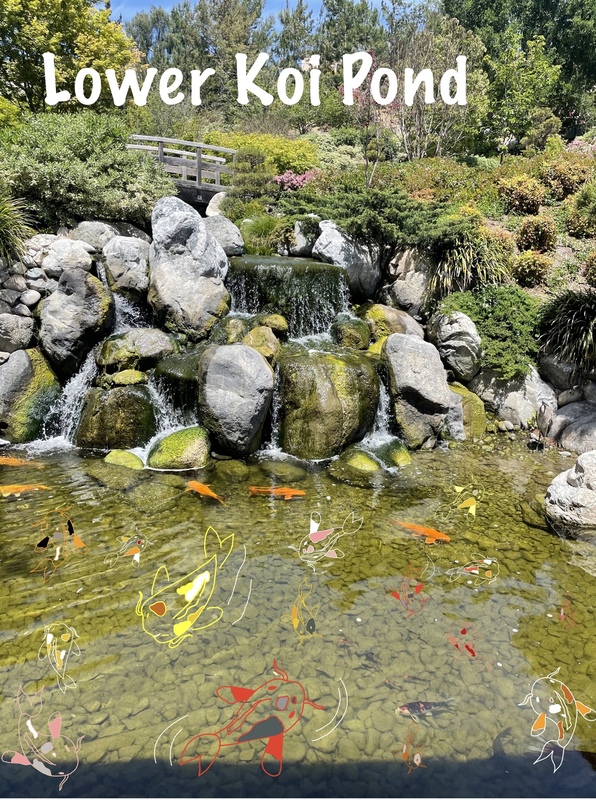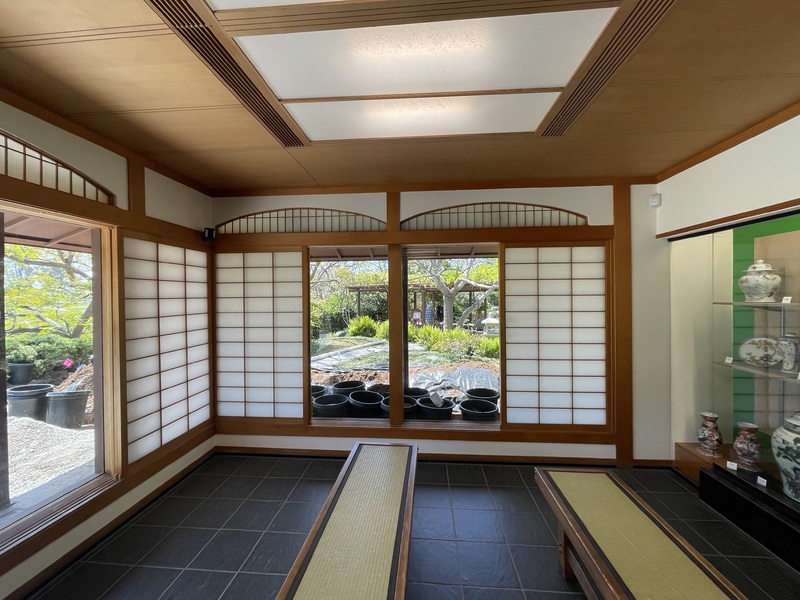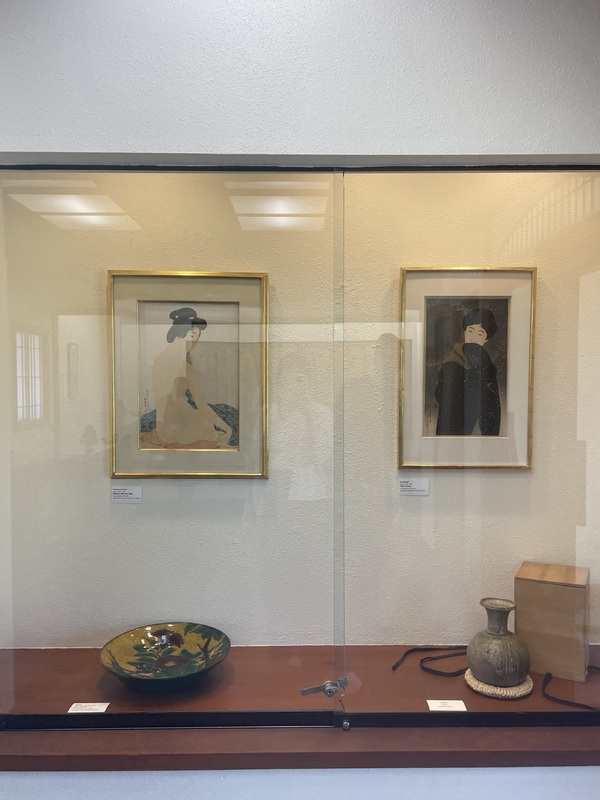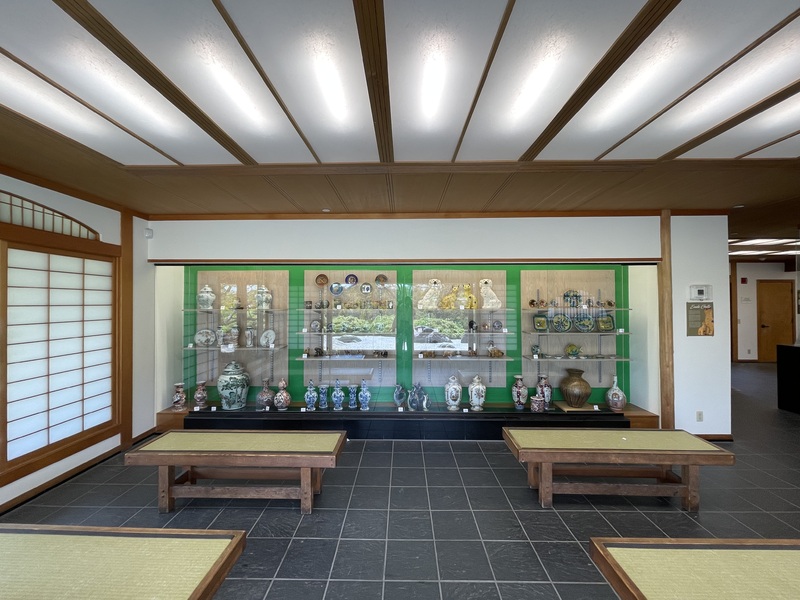The Modern Garden...Today
The mission statement of today's Japanese Friendship Garden (JFG) in Balboa Park is to develop a traditional Japanese garden as a center to educate, engage, and inspire people of diverse backgrounds about the Japanese culture and its community legacy in San Diego and beyond [1].
The upper garden koi pond is in the shaped like a mother turtle and is the home to JFG's show-quality koi fish. The small island in the middle of the pond is a design that is meant to represent a small baby turtle resting on the back of its mother [2]. This koi pond is home to the garden's aray of show quality koi, and the fish are hand-selected by the Koi Club of San Diego [3].
The koi pond in the lower garden is home to majority of the garden's fish population. The koi in this pond are often bred, and as such is home to many baby fish. The baby fish live here until they reach maturity, and are part of the Japanese Friendship Garden's Adopt-a-Koi sponsorship program where participants can 'adopt' a koi (4).
This bronze Kannon Bosatsu statue was donated to San Diego's Japanese Frienship Garden on December 20, 2018. Kannon Bosatsu is a goddess of Mercy and Compassion.
According to Buddhist tradition, Kannon was a Bodhisttva who chose to stay in the world after attaining Buddha Hood in order to aid those who were suffering. (5)
This statue was created in 1735 CE by Japanese sculptor Takumi Obata, an iron smith during the Tokugawa period (1602-1868). In 1930, American entrepreneur Rudolf S. Hecht and his wife Lynn acquired the statue and brought it back to the Middlegate Japanese Gardens in Mississippi (4). Unfortunately, in 2005 both the statue and the Middlegate Gardens were severely damaged by Hurricane Katrina, which lead to the garden's permant closure.
In 2015 San Diego art collectors Eugene and Marian Gabrych purchased the damaged Kannon Bosatsu statue and donated it to the San Diego Japanese Friendship Garden. The statue was restored with the help of the JFG and other donators and has found its new home in the lower garden (6).
The Inamori Pavilion represents a Frienship between Yokohama and San Diego the desgin of the building was built with these two cities in mind. It has the concept of a traditional Japanese garden tea building but altered to fit into the climate and enviorment that would suit San Diego. A blend of these two cities to make a building unquie to it.
In the below video by the JFG, architect Kotaro Nakamura describes the concept and execution that went into the creation of the Inamori Pavilion. He describes the location of the building as being controlled by the landscape where the bulding became a backdrop to the garden and its enviorment (6).
The Inamori Pavilion was bulit with two main style designs in mind, the Sukiya style and the Wabi-Sabi. The Sukiya style as Nakamura describes it, is an honest style, one where nothing is being hidden. Wabi-Sabi on the other hand is described as a very authentic Japanese sense of beauty. Wabi-Sabi comes form Zen Buddhism which regonzies beauty in imperfection allowing nature to take its course without resisting or controlling it (7).
*In the upper garden exhibit hall they are currently showcasing Maurice Kawashima art collection from March 10 up until June 30, 2023. This art instillation has pieces ranging from paintings, to pottery.
Works Citied
(1) Japanese Friendship Garden Pamphelt, "Japanese Friendship Garden San Diego: Our Mission," (San Diego: Japanese Friendship Garden 2023).
(2) Japanese Friendship Garden San Diego Pamphlet, "Japanese Friendship Garden San Diego: Japanese Garden Techniques," (San Diego: Japanese Frienship Garden 2023).
(3) Japanese Frienship Garden San Diego Pamphlet, "Japanese Frienship Garden San Diego: Upper Garden Features," (San Diego: Japanese Friendship Garden 2023).
(4) Japanese Friendship Garden San Diego Pamphlet, " Japanese Freindship Garden: Lower Garden Features," (San Diego: Japanese Friendship Garden 2023).
(5) Kannon Bosatsu Plaque, "Kannon Bosatsu Brozne Statue and Garden of Enlightenment," 2018, Japanese Friendship Graden, San Diego, Ca.
(6)"Bronze Kannon Bosatsu," Japanese Friendship Garden, https://www.niwa.org/kannon.
(7) An Introduction to the Inamori Pavilion, YouTube (Japanese Friendship Garden, 2020), https://youtu.be/PahcKTTEQlM.











